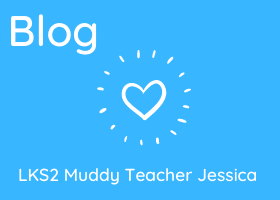By Muddy Teacher Jessica Habgood
Outdoor learning brings a class together
It is so easy to stay indoors and allow the children in your class to work through a workbook, a set of sheets or a set of slides. I started my topic on place value with my mixed year 3 and 4 class and I had some children who could do it standing on their head, rushing through 3- and 4-digit numbers then quickly moving onto calculations, whereas a handful of children sat, puzzled, fiddling with the place value counters and getting further behind their peers.
I’ve always disliked the idea of an obvious divide in a class and having set tables with some children seen as ‘good’ at a subject whilst others felt they were not. Getting out the base ten and the place value counters was fine but it wasn’t enough to engage and motivate all the children. I had to build these children’s confidence and enjoyment in their learning; I had to take the lesson outside!
So, we started our next lesson with a large bucket of chalks and some number cards. I started by challenging the children to create some 3- or 4-digit numbers outside. I initially gave them the numbers, then quickly realised there was no need as they could come up with their own. The more I let the children take ownership, the more they enjoyed it. I allowed the children to choose their partners but I suggested they worked with someone who they didn’t usually sit or work with. I asked them to be honest and say if they felt more or less confident. To my surprise, of their own accord, the children chose very mixed ability pairings.
The child who is usually sat slumped over his maths book looking confused, was stood tall, beaming, next to a child who usually works on his own beavering away on his greater depth extension tasks. Usually, this pair would never work together but their ideas bounced off one another. They started collecting stones, rocks and leaves and showed the numbers in a place value frame.
When you get outside, everyone relaxes and the atmosphere changes.
This includes the teacher! I also tend to relax when I am outdoors and go with the flow more and the children see the benefits of this in their lessons. If you are able to take a step back and let the children explore and take the lead, it will surprise you!
The artistic child used multiple coloured chalks and carefully used the ruler to make her place value frame look perfect. Whilst, one of my many energetic boys bounced around finding rocks, leaves and sticks to place inside it. They were discussing the maths- using key language and taking it in turns to use the chalk to write the numbers. But most importantly, they were all happy, confident and enjoying the learning taking place.
Looking around the class – everyone was involved in the learning. No one was sat on their own or disengaged. What was even better was that the children felt inspired to challenge themselves and enthused to share what they had done with the rest of the class. So, we paused the lesson and shared our number creations. All the children felt proud of their ‘natural number artwork’ as they had put a lot of effort into it. Some children had used feathers, others conkers, stones and grass. All of the children could explain how many hundreds, tens and ones there were. I encouraged the children to question each other. By being outdoors, everyone felt more confident to get involved, raise their hand or ask a question.
Knowing that this task would be quite simple for some of my higher achievers, I asked them how they could make it harder. They came up with their own challenge to do 2-place value frames and add them together. As I had not chosen the numbers and it was the start of the year, it meant that some of the calculations were quite tricky – but they enjoyed the challenge! It also meant that everyone experienced this as they worked alongside their partner, explaining what they were doing.
Some of the children who find presentation difficult did not need to worry outside. They could make their numbers large or uneven and it wouldn’t matter. There was less pressure outside. By being outdoors, the children were not being confined to their desk and a workbook. By keeping their numbers inside squared boxes, it meant there were less worries and gave everyone more of an equal opportunity to have a go with there was more freedom for creativity and movement.
Taking the learning outside removes many invisible barriers to learning which an indoor classroom can hold. Outdoor learning allows for freedom to move, boosts moral and brings your class together.
Like our Muddy ideas?
Spread the word and check out our ideas in action on our YouTube channel!
Follow on Twitter @MuddyTeachers
Chat with others on our Facebook Group Muddy Puddle Group
Follow our Facebook Page to see newly launched products The Muddy Puddle Teacher
Get tips and Ideas on Instagram @the_muddy_puddle_teacher
The Muddy Puddle Teacher ®
Here are 3 top outdoor learning ideas to get you started :
- Make sure the children have the right clothing – bring a muddy bag in or dress for mud that day!
- Make it messy and muddy – why not you are outside!
- Stick to natural resources – less clearing up for you and more kind to the environment.
Our muddy resources support all curriculums and we use only natural resources so any school, anywhere can use our approach. Including Early Years Framework, NC, CfE, American Curriculums.
Looking for a group subscription? We offer big reductions for schools and nurseries that book in groups. The more staff the more the discount per person. Click here for a quote.
Outdoor learning in primary schools is an essential way to bring wellbeing to the classroom.
Here are some muddy top tips to make a start in each key stage.
- Outdoor Learning KS2 – Try taking 10-minute slots or brain breaks in between sessions. Do the Muddy Walk and Talk and just use it for general discussion or chat.
- Outdoor Learning KS1 – Try taking phonics games outside. Choose a sound and use leaves
- Outdoor Learning EYFS – If you can make sure there is an outside space that is accessible and start to reduce the plastic and have more natural objects. Such as leaves they can write on, stones to do art with. Strip back the made plastic objects and keep natural for optimum imagination and creative skills to be used.
- Outdoor Learning KS2 – Try taking 10-minute slots or brain breaks in between sessions. Do the Muddy Walk and Talk and just use it for general discussion or chat.
- Outdoor Learning KS1 – Try taking phonics games outside. Choose a sound and use leaves
- Outdoor Learning EYFS – If you can make sure there is an outside space that is accessible and start to reduce the plastic and have more natural objects. Such as leaves they can write on, stones to do art with. Strip back the made plastic objects and keep natural for optimum imagination and creative skills to be used.
For more outdoor learning ideas for primary schools, sign up for FREE! If it is active learning you are looking for try GoNoodle a great way to get kids moving inside the class.
Watch the MPT safety videos to help you practice the best outdoor learning methods. These videos are also useful for those practising forest school.
Search for more outdoor learning resources : Babies (0-2) | Tots (2-4) | EYFS (4-5) | KS1(5-7) | LKS2( 7-9) | UKS2 (9-11) | Special Needs
For Training head to: Accredited Training | Short Certificate Courses
Have you also checked: Outdoor Ebooks | Assembly Packs | Home Learning Packs | Safety Support | Special Outdoor Events
- Support Outdoor Learning charities and head to Learning through Landscapes who can help with free outdoor learning ideas.
- Institute for Outdoor Learning are also a fabulous charity to refer to if you want to gather ideas for outdoor learning training and organisations.
- Look out for Green Flag Award to promote outdoor learning in primary schools through the muddy puddles approach.
The new way to do Outdoor Learning
Teacher Training | Teaching Resources
EYFS | KS1 | KS2
‘Learning outside for just one lesson a week boosts learning and behaviour, say, researchers’, Telegraph article read more
Get free guidance from OL Charity Learning through Landscapes


